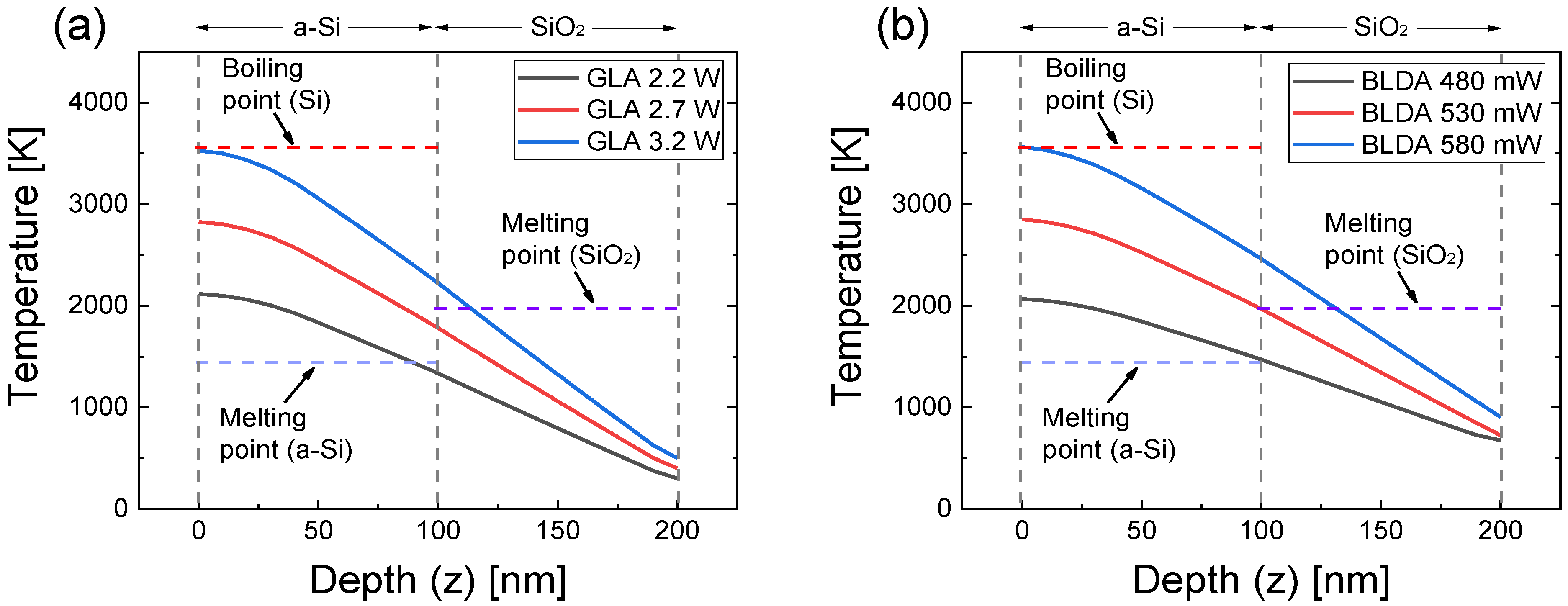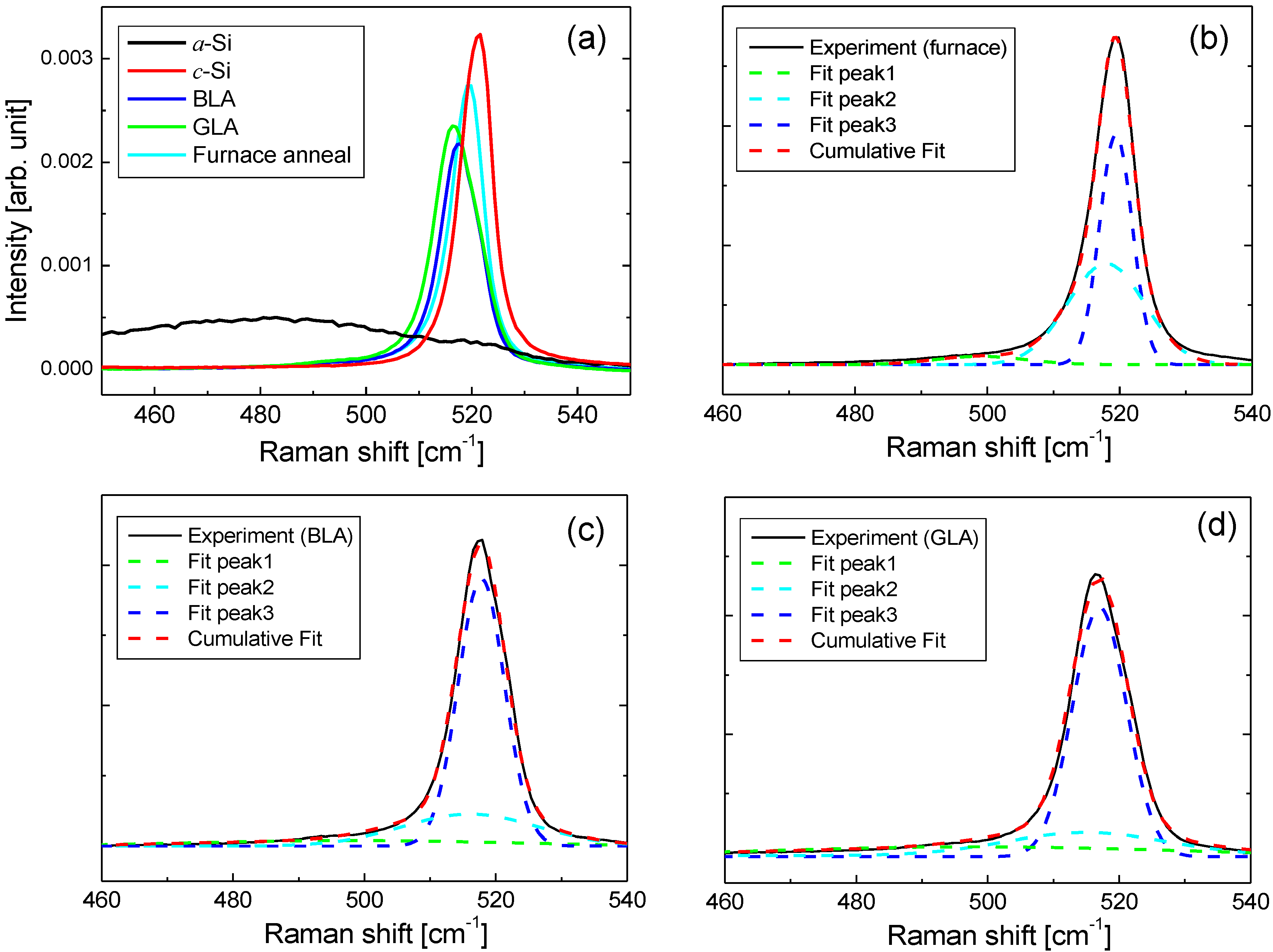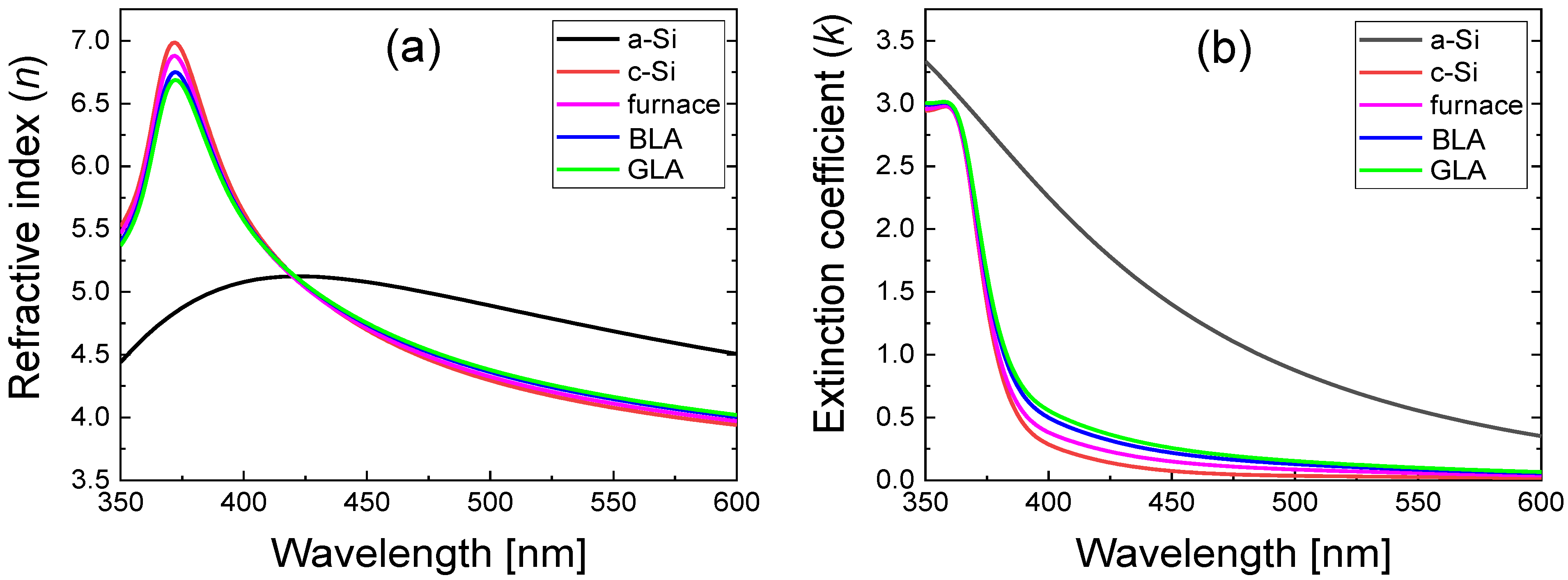Evaluation of Crystalline Volume Fraction of Laser-Annealed Polysilicon Thin Films Using Raman Spectroscopy and Spectroscopic Ellipsometry
Abstract
:1. Introduction
2. Methods
2.1. Thermal Simulation
2.2. Annealing Experiment
3. Results and Discussion
3.1. Thermal Simulation Results
3.2. Raman Spectoscopy
3.3. Spectroscopic Ellipsometry
4. Conclusions
Author Contributions
Funding
Data Availability Statement
Acknowledgments
Conflicts of Interest
References
- Stewart, M.; Howell, R.S.; Pires, L.; Hatalis, M.K. Polysilicon TFT technology for active matrix OLED displays. IEEE Trans. Electron Devices 2001, 48, 845. [Google Scholar] [CrossRef]
- Phillips, K.C.; Gandhi, H.H.; Mazur, E.; Sundaram, S.K. Ultrafast laser processing of materials: A review. Adv. Opt. Photonics 2015, 7, 684. [Google Scholar] [CrossRef]
- Theodorakos, I.; Zergioti, I.; Vamvakas, V.; Tsoukalas, D.; Raptis, Y.S. Picosecond and nanosecond laser annealing and simulation of amorphous silicon thin films for solar cell applications. J. Appl. Phys. 2014, 115, 043108. [Google Scholar] [CrossRef]
- Franta, B.; Pastor, D.; Gandhi, H.H.; Rekemeyer, P.H.; Gradečak, S.; Aziz, M.J.; Mazur, E. Simultaneous high crystallinity and sub-bandgap optical absorptance in hyperdoped black silicon using nanosecond laser annealing. J. Appl. Phys. 2015, 118, 225303. [Google Scholar] [CrossRef] [Green Version]
- Fortunato, G.; Mariucci, L.; Carluccio, R.; Pecora, A.; Foglietti, V. Excimer laser crystallization techniques for polysilicon TFTs. Appl. Surf. Sci. 2000, 154, 95–104. [Google Scholar] [CrossRef]
- Huet, K.; Mazzamuto, F.; Tabata, T.; Toqué-Tresonne, I.; Mori, Y. Doping of semiconductor devices by Laser Thermal Annealing. Mater. Sci. Semicon. Proc. 2017, 62, 92–102. [Google Scholar] [CrossRef]
- Huet, K.; Aubin, J.; Raynal, E.P.; Curvers, B.; Verstraete, A.; Lespinasse, B.; Mazzamuto, F.; Sciuto, A.; Lombardo, F.S.; La Magna, A.; et al. Pulsed laser annealing for advanced technology nodes: Modeling and calibration. Appl. Surf. Sci. 2020, 505, 144470. [Google Scholar] [CrossRef]
- Jhon, Y.M.; Kim, D.H.; Chu, H.; Choi, S.S. Crystallization of amorphous silicon by excimer laser annealing with a line shape beam having a Gaussian profile. Jpn. J. Appl. Phys. 1994, 33, L1438–L1441. [Google Scholar] [CrossRef]
- Fujii, M.; Ishikawa, Y.; Ishihara, R.; van der Cingel, J.; Mofrad, M.R.T.; Horita, M.; Uraoka, Y. Low temperature high-mobility InZnO thin-film transistors fabricated by excimer laser annealing. Appl. Phys. Lett. 2013, 102, 122107. [Google Scholar] [CrossRef] [Green Version]
- Jang, K.; Kim, Y.; Park, J.; Yi, J. Electrical and structural characteristics of excimer laser-crystallized polycrystalline Si1-xGex thin-film transistors. Materials 2014, 12, 1739. [Google Scholar] [CrossRef] [Green Version]
- Choi, D.H.; Kim, H.S.; Oh, S.Y.; Lee, C.H. Drastic improvement of as-sputtered silicon nitride thin film quality at room temperature by ArF excimer-laser annealing method. Curr. Appl. Phys. 2016, 6, 876–885. [Google Scholar] [CrossRef]
- Sugawara, Y.; Uraoka, Y.; Yano, H.; Hatayama, T.; Fuyuki, T.; Mimura, A. Crystallization of double-layered silicon thin films by solid green laser annealing for high-performance thin-film transistors. IEEE Electron Dev. Lett. 2007, 28, 395–397. [Google Scholar] [CrossRef]
- Kawamura, Y.; Yamasaki, K.; Yamashita, T.; Sugawara, Y.; Uraoka, Y. Crystallization by green-laser annealing for three-dimensional device application. J. Korean Phys. Soc. 2010, 56, 1456–1460. [Google Scholar]
- Beyer, W.; Andrä, G.; Bergmann, J.; Breuer, U.; Finger, F.; Gawlik, A.; Haas, S.; Lambertz, A.; Maier, C.F.; Nickel, H.N.; et al. Temperature and hydrogen diffusion length in hydrogenated amorphous silicon films on glass while scanning with a continuous wave laser at 532 nm wavelength. J. Appl. Phys. 2018, 124, 153103. [Google Scholar] [CrossRef] [Green Version]
- Sasaki, N.; Arif, M.; Uraoka, Y. Transition mechanism of the thin Si-films obtained by the CW laser lateral crystallization from the grain-boundary free highly {100} oriented crystal to the twinned {211} crystal depending on the laser power. Jpn. J. Appl. Phys. 2019, 58, SBBJ02. [Google Scholar] [CrossRef]
- Palani, I.A.; Vasa, N.J.; Singaperumal, M. Crystallization and ablation in annealing of amorphous-Si thin film on glass and crystalline-Si substrates irradiated by third harmonics of Nd3+: YAG laser. Mat. Sci. Semicon. Proc. 2008, 11, 107–116. [Google Scholar] [CrossRef]
- Nadarajah, A.; Könenkamp, R. Laser annealing of photoluminescent ZnO nanorods grown at low temperature. Nanotechnology 2010, 22, 025205. [Google Scholar] [CrossRef]
- Meyer, F.; Büchler, A.; Brand, A.A.; Dasa, M.K.; Nekarda, J.F.; Preu, R. Impact of solidification dynamics on crystal properties of silicon molten by a nanosecond laser pulse. Appl. Phys. A 2018, 124, 254. [Google Scholar] [CrossRef]
- Pyo, J.; Ryu, H.Y.; Park, J.; Lee, M.; Ryu, H.Y. Laser-power dependence of poly-silicon crystallization using 355-nm nanosecond laser annealing. J. Korean Phys. Soc. 2020, 76, 1116–1120. [Google Scholar] [CrossRef]
- Nocuchi, T.; Chen, Y.; Miyahira, T.; Mugiraneza, J.D.; Ogino, Y.; Lida, Y.; Sahota, E.; Terao, M. Advanced micro-polycrystalline silicon films formed by blue-multi-laser-diode annealing. Jpn. J. Appl. Phys. 2010, 49, 03CA10. [Google Scholar] [CrossRef]
- Jin, S.; Hong, S.; Mativenga, M.; Kim, B.; Shin, H.H.; Park, J.K.; Kim, T.W.; Jang, J. Low temperature polycrystalline silicon with single orientation on glass by blue laser annealing. Thin Solid Films 2016, 616, 838–841. [Google Scholar] [CrossRef]
- Choi, Y.H.; Ryu, H.Y. Formation of a polycrystalline silicon thin film by using blue laser diode annealing. J. Korean Phys. Soc. 2018, 72, 939–942. [Google Scholar] [CrossRef]
- COMSOL Multiphysics. Available online: https://www.comsol.com/products (accessed on 18 September 2020).
- Amin, M.S.; Hozhabri, N.; Magnusson, R. Effects of solid phase crystallization by rapid thermal annealing on the optical constants of sputtered amorphous silicon films. Thin Solid Films 2013, 545, 480–484. [Google Scholar] [CrossRef]
- Moschou, D.C.; Vourdas, N.; Davazoglou, D.; Kouvatsos, D.N.; Vamvakas, V.E.; Voutsas, A.T. On the optical properties of SLS ELA polycrystalline silicon films. Microelectron. Eng. 2012, 90, 69–71. [Google Scholar] [CrossRef]
- Kemiha, A.; Birouk, B.; Raskin, J.P. Ellipsometry-based conductivity extraction in case of phosphorus doped polysilicon. J. Mater. Sci. Mater. Electron. 2018, 29, 11627–11636. [Google Scholar] [CrossRef]
- Hong, W.E.; Ro, J.S. Kinetics of solid phase crystallization of amorphous silicon analyzed by Raman spectroscopy. J. Appl. Phys. 2013, 114, 073511. [Google Scholar] [CrossRef]
- Jin, J.; Yuan, Z.; Huang, L.; Chen, S.; Shi, W.; Cao, Z.; Lou, Q. Laser crystallization of amorphous silicon films investigated by Raman spectroscopy and atomic force microscopy. Appl. Surf. Sci. 2010, 256, 3453–3458. [Google Scholar] [CrossRef]
- Wei, W.; Xu, G.; Wang, J.; Wang, T. Raman spectra of intrinsic and doped hydrogenated nanocrystalline silicon films. Vacuum 2007, 81, 656–662. [Google Scholar] [CrossRef]
- Pyo, J.; Ryu, H.Y. Comparative study on crystallinity of laser-annealed polysilicon thin films for various laser sources. Mater. Express 2021, 11, 1239–1244. [Google Scholar] [CrossRef]
- Calcagnile, L. Laser induced phase transitions in Si and Ge implanted Si substrates. Phys. Stat. Solidi A 1995, 151, 23–32. [Google Scholar] [CrossRef]
- Theodorakos, I.; Raptis, Y.S.; Vamvakas, V.; Tsoukalas, D.; Zergioti, I. Laser annealing and simulation of amorphous silicon thin films for solar cell applications. Proc. SPIE 2014, 8967, 89670T. [Google Scholar]
- Caninenberg, M.; Verheyen, E.; Kiesler, D.; Stoib, B.; Brandt, M.S.; Benson, N.; Schmechel, R. Sample temperature profile during the excimer laser annealing of silicon nanoparticles. Opt. Laser Technol. 2015, 74, 132–137. [Google Scholar] [CrossRef]
- Saprykin, A.A.; Ibragimov, E.A.; Babakova, E.V. Modeling the temperature fields of copper powder melting in the process of selective laser melting. IOP Conf. Ser. Mater. Sci. Eng. 2016, 142, 012061. [Google Scholar] [CrossRef] [Green Version]
- Shrestha, M.; Wang, K.; Zheng, B.; Mokrzycki, L.; Fan, Q. Comparative Study of Furnace and Flash Lamp Annealed Silicon Thin Films Grown by Plasma Enhanced Chemical Vapor Deposition. Coatings 2018, 8, 97. [Google Scholar] [CrossRef] [Green Version]
- Snyder, P.G.; Xiong, Y.-M.; Woollam, J.A.; Krosche, E.R.; Strausser, Y. Characterization of polycrystalline silicon thin-film multilayers by variable angle spectroscopic ellipsometry. Surf. Interface Anal. 1992, 18, 113–118. [Google Scholar] [CrossRef]
- Valyukh, I.; Green, S.; Arwin, H.; Niklasson, G.A.; Wäckelgård, E.; Granqvist, C.G. Spectroscopic ellipsometry characterization of electrochromic tungsten oxide and nickel oxide thin films made by sputter deposition. Sol. Energy Mater. Sol. Cells 2010, 94, 724–732. [Google Scholar] [CrossRef] [Green Version]
- Gong, J.; Dai, R.; Wang, Z.; Zhang, C.; Yuan, X.; Zhang, Z. Temperature dependent optical constants for SiO2 film on Si substrate by ellipsometry. Mater. Res. Express 2017, 4, 085005. [Google Scholar] [CrossRef]








| Parameter | Type | Value |
|---|---|---|
| Density (ρ) | c-Si | 2329 kg/m3 |
| a-Si | 2260 kg/m3 | |
| SiO2 | 2203 kg/m3 | |
| Melting temperature | a-Si | 1420 K |
| SiO2 | 1986 K | |
| Heat capacity (Cp) | c-Si | 700 J/(kg·K) |
| a-Si | 992 J/(kg·K) | |
| SiO2 | 703 J/(kg·K) | |
| Melted Si | 965 J/(kg·K) | |
| Thermal conductivity (κ) | c-Si | 130 W/m·K |
| a-Si | 1.5 W/m·K | |
| SiO2 | 1.38 W/m·K | |
| Melted Si | 2 W/m·K | |
| Reflectivity (R) | 450-nm laser | 0.483 (a-Si), 0.7(Melted Si) |
| 532-nm laser | 0.403 (a-Si), 0.71 (Melted Si) | |
| Surface emissivity coefficient (ε) | a-Si | 0.5 |
| Melted Si | 0.7 | |
| Latent heat | a-Si | 1789.42 J/g |
| Convection constant (h) | air | 10 W/m2K |
| Absorption coefficient (α) | 450-nm laser | 0.0436 nm-1 |
| 532-nm laser | 0.0207 nm-1 |
Publisher’s Note: MDPI stays neutral with regard to jurisdictional claims in published maps and institutional affiliations. |
© 2021 by the authors. Licensee MDPI, Basel, Switzerland. This article is an open access article distributed under the terms and conditions of the Creative Commons Attribution (CC BY) license (https://creativecommons.org/licenses/by/4.0/).
Share and Cite
Pyo, J.; Lee, B.; Ryu, H.-Y. Evaluation of Crystalline Volume Fraction of Laser-Annealed Polysilicon Thin Films Using Raman Spectroscopy and Spectroscopic Ellipsometry. Micromachines 2021, 12, 999. https://doi.org/10.3390/mi12080999
Pyo J, Lee B, Ryu H-Y. Evaluation of Crystalline Volume Fraction of Laser-Annealed Polysilicon Thin Films Using Raman Spectroscopy and Spectroscopic Ellipsometry. Micromachines. 2021; 12(8):999. https://doi.org/10.3390/mi12080999
Chicago/Turabian StylePyo, Jeongsang, Bohae Lee, and Han-Youl Ryu. 2021. "Evaluation of Crystalline Volume Fraction of Laser-Annealed Polysilicon Thin Films Using Raman Spectroscopy and Spectroscopic Ellipsometry" Micromachines 12, no. 8: 999. https://doi.org/10.3390/mi12080999
APA StylePyo, J., Lee, B., & Ryu, H.-Y. (2021). Evaluation of Crystalline Volume Fraction of Laser-Annealed Polysilicon Thin Films Using Raman Spectroscopy and Spectroscopic Ellipsometry. Micromachines, 12(8), 999. https://doi.org/10.3390/mi12080999






